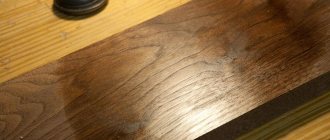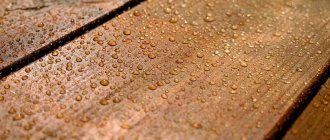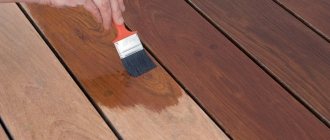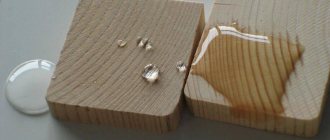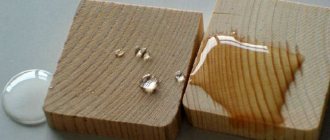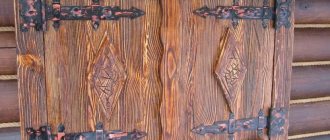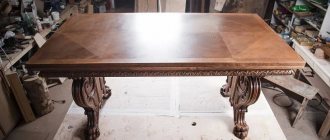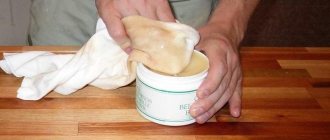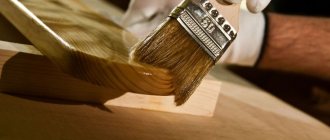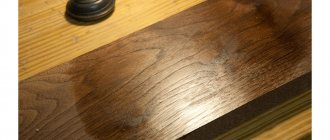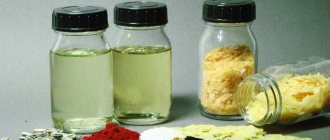You can emphasize the texture of a wooden surface with a special finish. Various stains and varnishes are offered for sale. They are easy to work with. But they have a big drawback - toxicity and unnatural composition.
Currently, waxing wood as a technology for preserving its structure is more popular. Natural wax or oils are used.
If varnishes form a film on the surface, then wax compounds penetrate deeper. At this moment, the pores are filled, which increases the strength of the surface and does not disturb the texture of the wood. The material is strengthened from the inside.
Benefits of Waxing
Waxing wood is called an effective technique for coating a wooden structure and has been used for years. The main components of wax compositions: beeswax, additives of inorganic origin, oils. Ready-made formulations are available for sale that can be used immediately after opening the container. They make the wooden surface smooth, with a touch of velvet. The wood texture becomes brighter.
- Waxing wood protects against moisture penetration.
- The coating allows the wood to breathe.
- The compositions protect against microbes and fungi.
- The surface is scratch resistant.
- Any type of wood can be processed.
- Manufacturers produce compositions of different colors.
- Beeswax is non-toxic and does not harm health.
- The treated structure emits a pleasant smell.
- The product retains its appearance for a long time
Wax is resistant to moisture, sun and chemicals. At home, these advantages will be useful for processing, for example, an oak barrel. Waxing an oak barrel will reduce losses when storing drinks in it.
How to properly apply wax to wood
A house equipped with wooden interior items looks respectable and cozy. But they need care. Treating wood with wax preserves and extends the life of furniture and floors. Each type of wax has its own characteristics in caring for a wooden surface.
Use for external and internal work
Wax is considered the best coating for decorating and protecting wood. The appearance of the tree improves and its quality characteristics are enhanced, which prolongs its life. Its different types are designed for indoor or outdoor work.
For outdoor wood treatments, wax is often combined with oil. They decorate and protect the facades of wooden housing constructions, gazebos, fences, small architectural forms and much more. Waxing the outside helps the wood resist environmental negativity, temperature fluctuations, UV rays of the sun, and high humidity. The level of surface resistance to water increases.
Wax consists of organic elements, which allows it to be used for finishing wooden products inside house buildings. It is possible to use it in children's rooms and bedrooms. Interior items made of wood retain their appearance for 5 years after treatment. A protective wax coating for the wood is formed that is velvety and pleasant to the touch.
The nature of damage to wood affects the choice of material type. Deep chips are treated with a solid compound, small defects are covered with 1-2 layers of liquid material. The shine of the parquet will return after two coatings in liquid form.
For small damage, it is convenient to purchase a wax pencil. This is an “ambulance” for removing minor scratches. To eliminate damage over large areas, restoration material is purchased in bulk containers.
Description of types of wax
Waxing is carried out by three types of wax: hard, oil, liquid. Each type is applied with its own nuances.
In solid state
Solid wax is more often used for restoration; areas with large cracks and chips are restored. The work includes a whole complex of preliminary and final stages. The tool used is a spatula.
A hard material is selected to protect the wood. It penetrates deeply and fills voids. All its properties are aimed at strengthening the base and protecting it from mechanical stress. The composition is used both indoors and outdoors. The permissible operating air temperature is 10-25 degrees above zero. The hard look restores deep damage to the wood structure.
Work with solid composition is divided into stages:
- The surface of the wood is cleaned of dust and dirt.
- The wax used to coat the wood is melted in a water bath.
- The wax mass in a liquid state is used to treat the problem area using a spatula. The material is pressed into the cracks or rubbing movements are made with a soft rag in the direction of the wood grain.
- The treated surface dries.
- Excess protective restoration layer is removed from the surface. The covering layer is sanded and polished with a cotton cloth.
Advice: deeply damaged areas are treated with more than one layer. When restoring, it is important to pre-calculate the material consumption and find the desired color.
Finishing material in liquid form
Small scratches and surfaces with small decorative details are treated with a liquid mass. The compositions are available in an assortment of shades, which allows you to choose the finish to match the color of the base.
The liquid consistency is maintained by special synthetic additives. It is more convenient to use. When applying liquid material, there are no smudges because it dries quickly. The top coat will be matte or glossy after additional polishing.
Working with liquid mass is carried out step by step:
- The old layer of paintwork is removed from the surface of the wood.
- For application, use a roller or brush.
- The second coating layer can be applied 2 hours after treating the wood for the first time.
- A soft cloth is used for sanding. To make the coating as glossy as possible, you need to polish it thoroughly.
Tip: The liquid material effectively restores the floor surface.
Colored wax composition
To restore furniture or to disguise chips in interior items, colored materials are used. Since regular wax forms an invisible transparent layer on the surface, it will not hide scratches on old furniture. Colored wax is selected to renew wood.
Manufacturers produce their own shades of finishing composition for any type of wood. When choosing them you need to know the rules.
| Wood base | The nuances of choosing wax color |
| Oak | Recommended finishes are black and brown. |
| Cedar and pine | Palette of shades in gold |
| Mahogany | Choose warm shades of orange and red |
Important: colored wax is not used when restoring chairs, tables, or armrests of furniture. Otherwise, the clothes will be stained with coloring pigment.
The color composition is applied in the same way as other types:
- Preparatory cleaning activities are being carried out.
- A decorative layer is applied.
Important: the protective layer with coloring pigment emphasizes the beauty of the natural wood pattern, and does not cover it.
Advantages and disadvantages of waxing wood
For wood, a wax coating has the following advantages:
- composition safety;
- the water-repellent characteristics of the base are enhanced;
- fungus and microorganisms do not appear;
- a shiny velvety decorative film appears;
- the composition enhances the structure of wood;
- the natural relief of the base and its warmth are emphasized;
- There is an assortment of shades of wax composition on sale.
We recommend: Tile varnish - application, properties and application technique
Impregnation for wood with wax also has disadvantages:
- the coating melts easily;
- under the influence of liquids containing alcohol, stains appear on the surface;
- spotty areas from exposure to the sun and water cannot be covered with wax;
- The countertop in the kitchen, restored with universal wax, often suffers from hot temperatures. Spots appear on the surface.
Manufacturers' choice
The quality of the restoration largely depends on the brand of wax material. Today, reviews on online sites and reviews help you understand offers from manufacturers. Company names:
- France, trademark "Liberon" and "V33". Wax putty for wood Liberon, restores damage to waxed or varnished wood and furniture.
- Italy, Borma Wachs. Various types are available. With their help, any problem can be solved. Easy to use at home. A line of wood gilding has been developed. For example, Beeswax gold silver Holzwachs.
- Russia, NPF "VAPA" and "Homa". The first company offers analogues of the best imported samples in terms of their consumer characteristics. The second one was developed - Homastic Wood Wax, frost-resistant.
Rating of popular wax materials
Wood products or furniture are common in the interior of many homes. To be able to promptly eliminate defects on the surface, it is better to always have a care product. Recommended for use:
| Brand | Technical description | Cost in rubles on Yandex.Market in 2021. |
| Liming Wax, Italy | Liquid composition with beeswax and carnauba, with white pigment. An antique effect is created. Container 0.5 l, drying speed - 2 hours. | 832 |
| "Black Bison", France | Liquid colorless composition. processes all types of wood. Sold in a range of colors. Container 0.5 l, drying speed – 24 hours. | 630 |
| Borma Wachs Stuccorapido, Italy | A soft processing material, available in pencil form. The variety of colors allows you to find the right color for local repairs. Drying speed – 2 hours. | 150 |
| White House, Russia | Solid composition in pencil form (15 g). For quick repair of wooden surfaces. Drying speed – 2 hours. | 199 |
| Hartwachs, Germany | Hard wax is applied to surfaces with intense traffic. Used in rooms with high humidity. Drying speed – 2 hours. Pencil 20 grams. | 234 |
Recipes for making wax at home
It is not difficult to prepare a restoration composition at home. Several recipes are in demand.
- beeswax – 1 share;
- turpentine (recommended oleoresin so that there is no pronounced odor) – 2 shares.
The wax is melted in a water bath. Turpentine is added to the mixture. The consistency is controlled by the amount of wax. It can be added if the composition is too liquid.
Treating wood with beeswax and olive oil, composition 2
- beeswax – 2 shares;
- olive oil – 7 shares.
The waxy material is crumbled into a jar and oil is added. The container with the contents is placed in a water bath until it is completely dissolved. The pigment creates the shade of the composition.
Tip: If the wax impregnation for wood is coated with an aerosol composition with natural resins, it will retain its appearance longer and receive a protective film.
Composition for waxing wood and methods of applying wax
Waxing composition
Treatment of wooden surfaces is carried out both at home and in industrial settings. The waxing composition is several components that are in different proportions among themselves, forming mixtures of liquid, soft and hard consistency.
Compositions are produced that differ in shades, density, viscosity, and consistency. They are based on one or several esters of higher acids and alcohols. They are beeswax. As a constituent element, various types of carnauba wax are often found. The basic composition includes vegetable oils: flaxseed and olive; ethereal extracts of pine needles; wood resins; drying oil Drying oil is not added if vegetable oil is used in the quick drying recipe. According to the technology, drying oil is formed spontaneously.
How does wood wax differ from oil?
As previously noted, waxing wood can be done either using wax paste or using linseed oil with wax. Oil, when applied to the surface, deeply saturates the wood without changing its natural texture. Wax forms a film at the treatment site that protects the product from abrasion and damage.
Wax for treating wood with linseed oil protects wood from rotting and drying out. To protect furniture located outdoors, you should use a special oil-wax for wood.
Waxing is a reliable method of protecting wood surfaces. In addition, it is inexpensive, which allows it to be widely used.
Wax impregnations are environmentally friendly and safe, as well as water-repellent properties. If required, you can change the shades or even the color of the coating.
Using mixtures of different consistencies
The choice of wax mixture based on consistency depends on the texture of the wood, the depth of cracks on the surface and their number. Minor damage is taken into account.
- A liquid composition or oil wax is used for application to surfaces with a large number of microdamages, with a small penetration depth. Oil wax contains a lot of natural solvent, which makes it look like regular varnish.
- A solid wax mass is applied to the surface with deep cracks if chips have appeared.
- Due to its variety of colors, soft wax (reminiscent of mastic) is matched to the interior so that the wooden item looks in tandem with textile elements.
Manufacturers offer the wax composition in jars of different capacities. Knowing its consumption, the material is purchased once for the entire wooden structure. A small area of wood is treated with a wax pencil.
Wax and forged products
Wax paint is well suited for processing forged metal objects. The protective film protects the base from moisture, preventing the formation and development of corrosive processes.
We recommend: How to remove oil paint from walls - the best and worst ways!
Wax compounds are applied to the metal after preliminary blackening. They retain a noble dark color. If you mix paint with marine varnish in a ratio of 5:1, the resulting composition will perfectly protect forged products from atmospheric factors.
To achieve the best result, you should prime the surface with red lead, then cover it with varnish and a wax mixture mixed with gasoline, waiting until it dries completely. After this, polish thoroughly.
Waxing technology
To work, you will need tools: sandpaper with different grains, a construction knife, a brush, a stiff brush, a soft cloth.
If the wood is processed for the first time, the wax material is easily distributed on the surface and is well fixed to it. Before applying wax or oil mixture to a previously painted surface, it is prepared.
Cleaning phase
The old coating layer is thoroughly cleaned from the wood.
- Begins with solvent treatment . A layer of paintwork or varnish is impregnated with an organic liquid. After this, the residue is removed quickly and easily.
- Leave the treated wood for a while to allow the solvent to evaporate.
- The wood is wiped with water at room temperature and then dried.
- Poorly removed paint residues are removed with a knife. The surface is protected with sandpaper. Remove paint from cracks with a brush.
Smooth wood is ready for waxing.
Useful video on the topic:
Application stage
Only dry products can be waxed.
- The mixture is distributed with a soft cloth, moving from the central area to the edges, corners, and curly elements.
- The liquid consistency composition is applied with a brush.
The hand moves in the direction of the fibers. Otherwise, the material does not fit well and is fixed on the surface. Soon the coating will peel off.
- The coating is left to dry when all the wood has been treated. In a dry and warm room, the layer will dry within an hour.
- By lightly touching an area hidden from view, you can check the degree of drying.
- Excess wax material (it is poorly absorbed even after the entire surface has dried) is removed with a cloth. These places are wiped with light movements.
Repeated application of wax or oil mixture will make the decorative surface even more beautiful.
At the finish the surface is polished.
Interesting video on the topic
Polishing
A special device with an electric drive is used. A rotating shaft connected to an electric drill quickly polishes the treated wood.
To preserve the natural appearance of the wood, it is covered with a transparent wax material. Toning is performed with a color composition. It is necessary to take into account the type of wood and the desire of the owners to obtain a specific shade of its surface. For example, brown and black impregnations are applied to dark oak. Wax in shades of the same color is applied to mahogany.
Content:
Various varnishes, paints, and oils are used to impregnate wood. One of the most reliable and proven means of protecting wood is wax. Waxing is one of the most ancient and high-quality methods of wood processing.
Wax improves the decorative functions of wood, emphasizes its texture, and gives the surface a velvety feel. Now the industry produces a wide variety of different wax compositions for application to wooden surfaces and furniture. The material, ready for use, consists of natural wax and various additives, including oils. Tools and materials for wood impregnation. These compositions can be used immediately after opening the package. The composition gives the surface smoothness, shine, and the required shade. It reliably protects wood from destruction and moisture. Any type of wood can be waxed, but it looks best on products made from pine and spruce. Modern industry produces compositions of various colors and shades.
Wax recipe
Waxing wood can be done using a wax product you make yourself: the recipe is known and the preparation technology is not complicated.
Components:
- Beeswax – 1 part;
- Turpentine – 2 parts.
The beeswax is broken into pieces. The pieces melt in a water bath. Turpentine is added to the warm grounds. More pieces of beeswax are added to the too liquid mixture. If you add carnauba wax, the coating will be more durable.
We recommend videos on the topic:
Mastic
Components:
- Wax – 100 g;
- Crushed rosin – 25 g;
- Turpentine – 50 g.
Pieces of wax are melted in a water bath. Rosin is added to the mass. When the pieces melt, turpentine is poured in. The addition of propolis adds flavor to the composition. A coating with this additive strengthens the wood. The finished composition is removed from the heat and a tin container is filled with it. The mixture should cool. Gradually it thickens and becomes pasty.
Cooking methods
It's time to talk about how to prepare oil-wax at home and what components are required for this. For greater convenience, we will give the mass fraction of the ratio of ingredients. Follow this recommendation and you will be able to prepare a high-quality product for treating wood floors.
Wax, turpentine and rosin
This composition is ideal for furniture because it allows you to create a special protective film, thanks to which dust does not harm the surface of the wood in any way, and a characteristic coating does not form on top.
This became possible thanks to the addition of turpentine. It makes the composition not so thick, which simplifies application and allows you to work with the surface as much as necessary.
